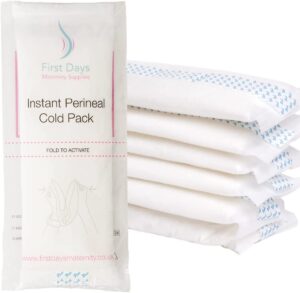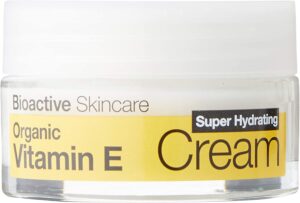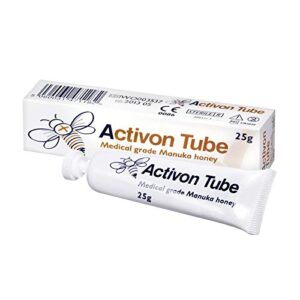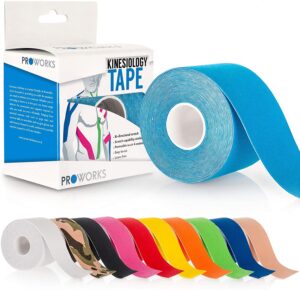A caesarean delivery is a birth that occurs through an incision in the abdominal wall and uterus rather than through the vagina. According to new research from the World Health Organization (WHO), caesarean sections are now accounting for more than 1 in 5 (21%) childbirths.
Factors affecting your recovery:
-
Amount of sleep you get following the surgery
-
The circumstances behind having the surgery (i.e. planned or emergency)
-
The weight of your baby
-
The way you feed your baby (using breast or bottle will change your feeding positions and posture throughout the day – one isn’t superior to the other, both will affect recovery in different ways)
-
Your age
-
Any previous health conditions that may slow your bodies healing process down
-
Whether you are a smoker or not (evidence shows that smokers tend to have a delayed healing time)
-
Your support network
-
Previous fitness levels
-
Your diet
-
Whether you have other children at home that you are the main carer for
-
Postnatal Depression
Symptoms following a c-section
-
Symptoms will vary from one lady to the next (based on the aforementioned factors).
-
Pain is an inevitable consequence of surgery, evidence has shown that pain levels will vary widely from one lady to the next, don’t compare your recovery to anybody else’s.
-
Significant reduction in pain levels tends to happen between 2-4 weeks post-surgery (according to this study from 2018). Pain can continue at varying levels however, for several weeks or even months.
-
The incision will be red and raised initially (and will seem really obvious to you ) but will slowly become paler and flatter over the next few weeks. The scar tissue will continue to change in appearance over the coming weeks and even years, but is generally considered ‘healed’ after 6-8 weeks (if there are no complications like infection).
-
Feeling weak, dizzy or nauseous can also come after a major surgery. Some of this might be medication related and some will just be your body recovering. Be sure to drink plenty of fluids and eat regularly to keep your energy up.
-
Feeling emotional, or having up / down moods is also really common following the birth of your baby, whether that is via caesarean or vaginal, your hormones will change a lot and quite quickly. This is quite normal and will usually pass gradually over a few weeks or months following birth. Evidence is conflicting as to whether caesarean births are more likely to lead to postpartum depression than vaginal births. This study found that the method of birth wasn’t the contributing factor but more likely the ‘circumstance’ of the birth that was the issue, i.e. emergency section or vacuum births were more likely to contribute to PND.
Treatment recommendations in the first 24hrs and up to 6 weeks after caesarean surgery:
After your surgery you should be encouraged to get up and start moving around. It is common to feel dizzy, nauseous and afraid or anxious at this point. Take your time but follow the advice closely as it can really help your recovery time and result.
If you had any complications during pregnancy or birth, or you have any medical problems, get advice from your GP or a physiotherapist before starting any type of exercise or treatments.
Hints and tips:
Chewing gum – After a C-Section, it is common for the bowel to stop working for several hours or days. Although this usually resolves by itself in a few days, it may be very uncomfortable in this time. The available evidence suggests that gum chewing in the immediate postoperative period after a C-Section is a well tolerated intervention that enhances early recovery of bowel function, so get some packed in your hospital bag.
Aromatherapy – This study examined the effect of peppermint spirits on postoperative nausea in women following a scheduled C-section. They found that there was good evidence to suggest that the Peppermint may be a useful adjunct in the treatment of their nausea. Therefore, another potentially useful addition to your hospital bag! Here is a great little bottle at a reasonable price that you can buy (with over 15 thousand good reviews).
Abdominal binder – This study found that the use of an abdominal binder postoperatively (in abdominal and caesarean patients) significantly reduced pain and improved mobility. Talk to your doctor or health care provider about this as an additional treatment option after your operation.
Here is a great example of a support garment (abdominal binder) that comes with really good reviews.
Ice – This study found that ice packs are a simple, cost-effective adjuvant for decreasing postoperative pain and narcotic use in patients undergoing major abdominal operations. Ice can help reduce the itching as your incision heals but don’t use it too often as it does slow blood supply to the area. 2-3 times a day is usually recommended and no more than 15 minutes at a time. We really like THESE instant perineal cold packs because you just fold them to activate the cooling effect and they can be stuck to clothes to keep them in place. A good hospital bag investment for vaginal OR caesarean birth.
Acupuncture – There have been a few studies done that look into the effectiveness of acupuncture on postpartum recovery following a c-section. The studies have shown that daily acupuncture can promote uterine contraction, reduce postpartum blood loss and lochia duration and benefit uterine involution (return to its original state) after caesarean section. Unfortunately, the studies reporting this were based on very small numbers and it is not easy to seek this treatment when you have a new baby and have just had major surgery.

Advice on exercise and movement following your surgery:
Watch this video by the amazing Hollie Grant (in association with Nessa). Hollie is an advanced pre and postnatal fitness specialist and is keen to get ladies moving and back to their pre-pregnancy health.
Movement – evidence shows that early movement after a caesarean can enhance recovery and result in an earlier discharge. Standing up and moving around can start as early as 2 hours after the operation. Another study that we found reported improvement in overall long-term mobility, following caesarean sections, when early activity was encouraged.
Walking – Once you are up and moving after your operation then you want to stay as active as feels comfortable to you. Little and often is usually key to help with circulation and reduce any chances of a DVT developing. THIS study found that mobilisation out of bed, with or without breathing exercises, within 2 hours after elective abdominal surgery improved arterial and peripheral oxygenation. This means quicker healing and less chances of complications. Aim for 10 minutes walking daily initially, this doesn’t have to be all at once, it can be 2 minutes 5 times a day. Try to increase your walking time by 5 minutes each week.

Exercises – While protocol suggests that we wait until our 6-week check up to get the go ahead for post-birth exercise, there are things that you can be doing in the first 6 weeks (and as early as 1 day post-op) that will help to aid your recovery;
- Pelvic Floor strengthening exercises – Many studies have shown the effectiveness in pelvic floor exercises when it comes to improving pelvic floor strength and incontinence symptoms. THIS study found that pelvic floor training exercises could cure or improve symptoms of stress incontinence in particular but also were effective on all other types of urinary incontinence. These exercises are safe to be started straight after surgery.
- Mobility exercises – Have a look at this video by Today Parent. This shows really clearly how to do some exercises that are recommended straight after birth (speak to your midwife about these on your first follow-up appointment). They are simple, should be pain free but can help aid your recovery.
- Calf / ankle pump exercises – another exercise that is usually recommended after your operation is ‘calf or ankle pumping’. This involves moving your feet up and down or pointing your toes and then relaxing them. You can do these lying down, sitting up and standing up (holding onto a wall or table for support). Aim for 10 at a time and do them every few hours (more if you’re sitting / lying down during the day).
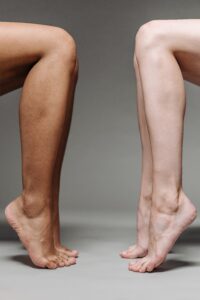
A word on postnatal depression – While evidence suggests that the mode of delivery has no direct impact on risk of postpartum depression, it has been found that women delivering in an emergency setting by emergency caesarean section or vacuum extraction, and reporting negatively experienced delivery, constitute a high-risk group for postpartum depression.
HERE is what the NHS recommend to help with postnatal depression.
Treatment recommendations weeks 6-12:
Scar massage – The general guideline is to start scar massage around the 6-week postpartum mark, wait for your 6-week postpartum check-up to get the go ahead. Your healthcare practitioner will check that the scar is fully healed with no signs of infection or other complications. Bear in mind that it is never too late to start scar massage, even years after your c-section you can make a difference to the scar tissue. A moderate-to-strong effect on pain reduction and scar appearance was observed in THIS study when treating the scar with massage.
HERE is a great example of how to carry out massage on your scar tissue following a caesarean section. There is a lot of advice online regarding what creams and gels to use for massage over scar tissue.
Popular remedies include: honey, vitamin E creams, Vaseline and Aloe Vera.
There are some promising results from the studies that we looked at, for the various remedies available, but there are no studies (to our knowledge) that compare them all to see if there is a superior option.
It would be a safe bet to say that it comes down to personal preference and more importantly, technique, frequency of the massage, genetics and how early you are able to start working on the tissues (6 weeks is usually the earliest you would be advised to start massage but speak to your healthcare provider about this). It is worth noting that creams containing vitamin E are not usually advised on wounds younger than 6 weeks and they have a higher rate of allergic reaction than the other options mentioned above.
Sillicone gel – when looking at scar appearance (pigmentation) and flexibility, evidence is very much in favour of the use of silicone gel. THIS study found that applying a silicone gel twice a day on hypertrophic burn scars reduced the scars appearance significantly. They proposed that the silicone applications positively influenced the scar tissue through wound hydration.
HERE is a silicone gel that we found that has really good reviews and is reasonably priced.
Sillicone sheets – Similarly to silicone gel applications, silicone gel sheets were demonstrated to have a large and positive effect on pigmentation of hypertrophic burn scars.
HERE are some gel sheets with really good reviews.
For more information on when to use scar sheets and for how long, check out THIS website which goes into some great detail.
TENS – Research has shown that TENS can be useful at reducing the pain from your caesarean surgery (as early as a few hours post surgery). Speak to your GP or healthcare provider about this option, it is a great alternative to taking medication but you need to make sure that it is the right course of management for you.
There are many different TENS machines available to buy, so if you are thinking of TENS as a treatment option then have a look at our Top 5 picks to make things a little easier.
Exercise – If everything went to plan and you have been given the all clear by your healthcare provider then it’s time to start building your exercise levels back up. To start with you want to keep your exercise as low impact and with no heavy weights. Here is what we recommend to get you started and to help avoid any complications in the months following your caesarean:
- Pilates: evidence does support the use of Pilates-based exercise during & after pregnancy for the treatment of many conditions including pelvic floor strength and strengthening the abdominal muscles. This study found that Pilates increased strength in the abdominal wall and prevented any asymmetric developments. Have a look at our Top 5 Online Pilates programmes here.
- Yoga – There have been a lot of studies that have looked into the benefits of yoga. This study found that yoga enhanced muscular strength and body flexibility, promoted and improve respiratory and cardiovascular function, reduced stress, anxiety, depression, and chronic pain, improve sleep patterns, and enhance overall well-being and quality of life. There are lots of Online Yoga programmes available, have a look at our Top 5 here (and why we love them)! You can also read our blog on how yoga can help in other ways.

- Kinesio Taping – This study looked at the effects of exercise PLUS taping in the recovery from caesarean section surgery. It is a small study but results demonstrated that the addition of Kinesio tape to abdominal exercises provided greater benefit for the abdominal recovery in women following their caesarean sections. Here is a tape that we would recommend (because we use it in our clinics) and here is a video showing one taping method for abdominal pain that can also help constipation (common after a caesarean). There are a few different techniques used for abdominal taping so speak to your physiotherapist about what might suit your needs.
Treatment recommendations weeks 12+:
Pilates – Pilates is a great exercise you can try which focuses on the pelvic floor and core strength. It is low impact and effective even if you are starting 12 months after your surgery. Have a look at our Top 5 Online Pilates programmes here.
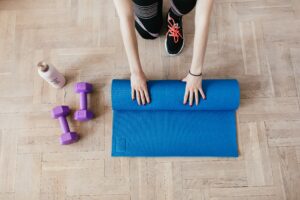
A note on Pain – Studies found 60% of women still experience wound pain near their incisions at 24 weeks post-birth. Three months after delivery, studies found women with C-sections were more likely to have abdominal pain than those with vaginal births. Do not compare yourself to anyone else as every woman’s recovery is so different. If you have any concerns about the way you are progressing then speak to your healthcare provider or seek advice from a local Women’s Health Physiotherapist.
The Association of Chartered Physiotherapists in Women’s Health (ACPWH) suggests that women who have had caesarean surgery should wait 8 to 10 weeks before commencing vigorous exercise. This might be exercise which you previously participated in or you might be starting a new exercise. Either way, be sure to build up slowly.
What symptoms to watch for following your c-section:
The NHS recommends that you contact your midwife or a GP straight away if you have any of the following symptoms after a caesarean:
- severe pain
- leaking urine
- pain when peeing
- heavy vaginal bleeding
- your wound becomes more red, painful and swollen
- a discharge of pus or foul-smelling fluid from your wound
- a cough or shortness of breath
- swelling or pain in your lower leg
These symptoms may be the sign of an infection or blood clot, which should be treated as soon as possible.
Hints and tips from mums who have recovered from their caesarean surgery:
“Stay active but support your stomach area when you have to strain. Using laxatives also really helped me initially”.
“Knowledge of what to expect, what the surgery involved, recovery times and knowing the do’s and don’ts after the surgery was really reassuring”.
“Getting enough rest and getting support from family and my partner helped me to focus on me and baby (and not the housework etc)”.
“Having a high changing table helped with lifting and bending in the early days”.
“Gentle walks a little bit at a time but staying active, regular stretching was key”.



